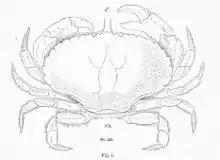Jonah crab
The Jonah crab (Cancer borealis) is a marine brachyuran crab that inhabits waters along the east coast of North America from Newfoundland to Florida.[1] Jonah crabs possess a rounded, rough-edged carapace with small light spots, and robust claws with dark brown-black tips. The maximum reported carapace width for males is 222 mm, while females rarely exceed 150 mm.[2] It is the closest relative to the European brown crab in the Western Atlantic.
| Jonah crab | |
|---|---|
.jpg.webp) | |
| Scientific classification | |
| Kingdom: | Animalia |
| Phylum: | Arthropoda |
| Subphylum: | Crustacea |
| Class: | Malacostraca |
| Order: | Decapoda |
| Infraorder: | Brachyura |
| Family: | Cancridae |
| Genus: | Cancer |
| Species: | C. borealis |
| Binomial name | |
| Cancer borealis Stimpson, 1859 | |
Habitat and behavior
Jonah crabs have been reported at depths of up to 750 m.[1] Habitat preferences for Cancer borealis range from rocky substrate in Rhode Island and the Gulf of Maine to silt and clay substrate on the continental slope.[2] It is widely accepted that this species moves offshore in the fall and winter, and females have been documented moving inshore in late spring and summer.[3] The Jonah crab is known to move to areas of preferred temperature for behavioral thermoregulation.[4] The preferred temperature of this animal changes depending on the temperature to which it is acclimated. The estimated average preferred temperature is 15.4 °C (59.7 °F).[4]

Diet
According to stomach content analysis on individuals from the Gulf of Maine, the diet of Cancer borealis consists of mussels, arthropods, snails, and some algal species. Blue mussels (Mytilus edulis) composed more than 50% of analyzed stomach contents.[5]
Fishery
Jonah crabs have long been caught as bycatch in lobster traps. Once, they were considered a nuisance and a pest that stole the bait in the traps and they were thrown back in the sea by many an angry fishermen. In the past twenty years, particularly in New England, landings have increased due to increased fishing pressure and market demand. Landings of Cancer borealis in the United States rose from 2-3 million pounds annually in the 1990s to more than 17 million pounds in 2014. In 2014, 70.05% of landings came from Massachusetts, followed by Rhode Island with 24.43%. Jonah crabs are not managed federally in the United States, but instead are managed by individual states with interstate coordination by the Atlantic States Marine Fisheries Commission.[3]
Cooking
Jonah crab has a sweet taste and though it is not as meaty as the West Coast Dungeness crab, it is fine eating. The claws can be served steamed and served chilled over ice for an appetizer and the meat makes an excellent crab cake, which in New England is often a part of a sandwich served with mayonnaise.[6] Seafood based broths and Asian style soups can be made from the shells and the texture is as fine as snow crab but as firm as Florida stone when prepared properly.[7]
References
- Paul Haefner (1977). "Aspects of the biology of the jonah crab, Cancer borealis Stimpson, 1859 in the mid-Atlantic Bight". Journal of Natural History. 11 (3): 303–320. doi:10.1080/00222937700770221.
- D. A. Rochibaud & C. Frail (2006). "Development of Jonah crab, Cancer borealis, and rock crab, Cancer irroratus, fisheries in the Bay of Fundy (L FAs 35-38) and off southwest Nova Scotia (LFA 34): from exploratory to commercial status (1995–2004)" (PDF). Canadian Manuscript Report of Fisheries and Aquatic Sciences. 2775 (iii).CS1 maint: uses authors parameter (link)
- "Interstate Fishery Management Plan for Jonah Crab" (PDF). Atlantic States Marine Fisheries Commission. Retrieved 27 October 2015.
- Lara Lewis & Joseph Ayers (2014). "Temperature preference and acclimation in the Jonah crab, Cancer borealis". Journal of Experimental Marine Biology and Ecology. 455: 7–13. doi:10.1016/j.jembe.2014.02.013.CS1 maint: uses authors parameter (link)
- Megan J. Donahue, Allison Nichols, Carlos A. Santamaria, Paloma E. League-Pike, Cory J. Krediet, Kestrel O. Perez & Myra J. Shulman (2009). "Predation risk, prey abundance, and the vertical distribution of three brachyuran crabs on Gulf of Maine shores". Journal of Crustacean Biology. 29 (4): 523–531. doi:10.1651/08-3061.1.CS1 maint: uses authors parameter (link)
- "From Bycatch to Center of the Plate: Jonah Crab". Pangea Shellfish Company | Oyster and Shellfish Wholesale. Retrieved 2019-02-18.
- "Jonah Crabs Claw Their Way Up in Culinary Credibility". hamptons-magazine.com. Retrieved 2019-02-18.
